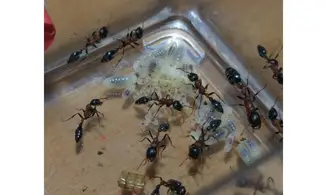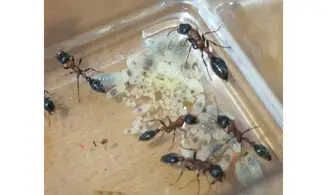Latin name: Tetraponera rufinigra
Taxonomy: Subfamily: Pseudomyrmecinae Tribes: Pseudomyrmecini
Breeding level: Experienced as a painful sting.
Geographic distribution: India, Java, Sri Lanka, Nicobar, Myanmar, Vietnam, China.
Habitat: Tropical tropical forest to subtropical
Colony form: Monogyne
Queen: Size: 12 - 15mm Color: Black head and gastre, orange red thorax
Workers: Size: 10 - 12mm Color: Black head and gastre, orange red thorax
Soldier: No
Male: Size: 12 - 15mm Color: Black
Food: Honeydew and insectivores, like meal worms, fly, mosquito, crickets etc ...
Humidity: Hunting area: 60 - 70% Nest: 60 - 80%
Temperature: Hunting area: 24 - 30 ° C Nest: 26 - 30 ° C
Hibernation: No
Nest type: Plexiglas nest, nest with tubes, reconstituted stone nest.
Description: Ants narrow and elongated, she is extremely graceful. They are very active and highly adapted to the arboreal lifestyle. They are very aggressive against nesting and have a painful sting.
Their habitat is usually totally dry dead trees with a tiny nest entrance that leaves just past a worker in order to be protected from predators. This species requires no moisture in the nest but just a water trough in the hunting area which makes it easy to breed for a Pseudomyrmecinae.
Their ability to hunt insects is spectacular with very good eyesight, speed of movement and a very efficient sting.
They have a very strong recruitment capacity by tapping the abdomen on the ground.
This species is only for individuals with experience with closed hunting grounds.
Development: Swarming from January to March.
Foundation: Semi-claustral (with food) Development: 60 days from egg to worker (depending on temperature)
Size of the colony: From 500 to 1000 individuals, the queen can reach the age of 12 years.


